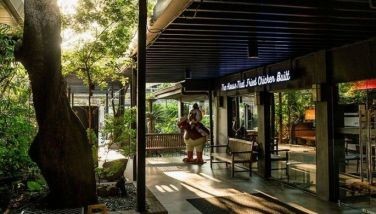Basi: The brew that launched a revolt
October 22, 2005 | 12:00am
 In earthen jars buried in the farmers’ yards of the northern Philippines, a centuries-old tradition lives on, embodying the spirit of ancestors who fought and died for their right to party.
In earthen jars buried in the farmers’ yards of the northern Philippines, a centuries-old tradition lives on, embodying the spirit of ancestors who fought and died for their right to party.
"It makes you courageous, sharpens your appetite and puts you into a party mood," says Salustiano Mariano, a 60-year-old sugar cane planter who has been producing the dark-colored, faintly sweet-tasting liquor called basi for more than 40 years.
Spain introduced the cash crop to its Southeast Asian colony more than 300 years ago to produce sugar to help finance the running of Spain’s global empire. But the farmers on the narrow coastal plains of the Ilocos region found a more imaginative use for the plant.
Tribal groups in the nearby Cordillera highlands drink basi to cement the end of a clan war, while young men in the Ilocos bear a gallon of their finest brew when they take their parents to their future daughter-in-law’s home to make a formal marriage proposal.
Little wonder then that the people here rose up in armed rebellion 199 years ago when the colonial government imposed monopoly control over the production and consumption of the liquor.
Mustering from the adjacent town of Piddig, the basi rebels swept across the region, overwhelming Spanish garrisons before a superior colonial force crushed the uprising. The leaders were later captured, tried and hanged.
The people of Bacsil North, living among fields sheltered by hills, have little or no recollection of their ancestors’ rebellion, but the basi craft runs through their veins.
"We learned this trade from our great-grandparents. We can produce basi even with our eyes closed," Mariano tells Agence France Presse as he prepares to sample last year’s vintage in neighbor Lolita Agtarap’s yard.
The harvest from the Agtarap family’s five-hectare spread is stored in about 200 giant earthen jars, half buried under the shade on their front yard beside a mill. She and her husband bought some of the jars 29 years ago, shortly after they were married.
Using two or three intermeshed solid-iron cylinders, the cane stalks are pushed between the drums to squeeze out the juice. A water buffalo, its eyes hooded to prevent disorientation, draws a long sweep around the contraption to make the drums turn.
The farmers previously used trunks of hard wood to mill the cane, but now these relics are mostly found in museums or art shops.
The drink of choice
The cane pulp, called bagasse, is then used as kindling to fire up massive iron vats where the juice is boiled for about an hour before storage.
Quite unlike distilling rum, which uses molasses produced from cane juice, the liquid is seasoned with the crushed leaves, fruits and bark of a cinnamon-like tree locally called samak to give basi its flavor and bitter aftertaste, and sealed with banana leaves and a clay cover to ferment.
Each jar contains between 40 and 80 liters of the liquid. Basi is retailed at about the same price as Philippine beer, about P20 a bottle.
The wine is ready in as little as three months, though this basi-producing village is known to keep them for years to improve the taste. It is then served only for the most important of occasions.
"It’s the drink of choice of the locals, who prefer it to gin," Mariano says. "Basi is all-natural, and besides it is cheaper than beer. But if you offer me basi and beer, I will have both, thank you!"
Alternatively, the boiled cane liquid is turned into vinegar, a key ingredient of Ilocos cuisine.
"The liquid turns into basi first, then vinegar. But if you want to speed up the process, you just leave the jar open and it will turn into vinegar fast," Agtarap says.
The annual sugar cane harvest starts in December and January, when the stem cuttings for the next crops are also planted.
More than 30 families plant the crop in Bacsil North and about 90 others in the adjacent hamlet of Bacsil South, making these areas the center of the basi brewing industry in the north, says Bacsil North village chief Marcial Manuel.
"Vegetable farming is too tedious and too expensive for many of them," he tells AFP. "With sugar cane, you just plant it, fertilize it and then wait for the rain."
Just 257 hectares of Ilocos Norte farmland is planted to sugar cane, and almost all the output goes into producing basi or vinegar, says Norma Lagmay, the provincial agriculture officer.
Most of the output is consumed locally, though there has been some interest from basi drinkers in Manila, she adds. Local officials have been meeting in a bid to "patent the basi and vinegar from Bacsil," Lagmay says.
Manuel says the farmers have taken educational field trips to the factories of some of the country’s top beverage firms to look into possible packaging tie-ups.
BrandSpace Articles
<
>
- Latest
Latest
Latest
March 15, 2025 - 4:56pm
By Katrina Guerrero | March 15, 2025 - 4:56pm
March 8, 2025 - 4:00pm
By Renato Cruz De Castro | March 8, 2025 - 4:00pm
March 8, 2025 - 3:43pm
By Jing Castañeda | March 8, 2025 - 3:43pm
March 1, 2025 - 10:00am
By Venice Isabelle Rañosa | March 1, 2025 - 10:00am
February 22, 2025 - 5:26pm
By Rupert Paul Manhit | February 22, 2025 - 5:26pm
February 15, 2025 - 9:00am
By Joyce Ilas-Reyes | February 15, 2025 - 9:00am
Recommended
























